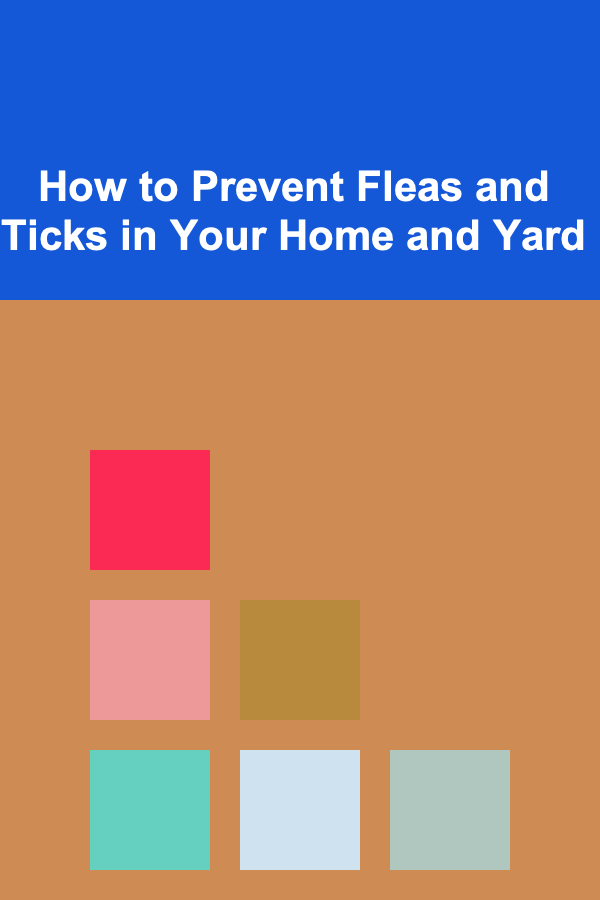
How to Prevent Fleas and Ticks in Your Home and Yard
ebook include PDF & Audio bundle (Micro Guide)
$12.99$6.99
Limited Time Offer! Order within the next:

Fleas and ticks are not only an inconvenience for pet owners, but they also pose serious health risks to both humans and animals. These tiny, blood-sucking parasites can infest your pets, home, and yard, leading to discomfort, skin infections, and even the transmission of diseases. Prevention is key to avoiding the problems associated with fleas and ticks, and taking a proactive approach can protect both your family and pets from these pests.
In this comprehensive guide, we will explore how to effectively prevent fleas and ticks in your home and yard, providing you with practical steps to eliminate these pests and keep your living spaces free from infestation.
Understanding Fleas and Ticks: The Basics
Before diving into prevention techniques, it's essential to understand what fleas and ticks are, their lifecycle, and why they are such a threat to our pets and homes.
Fleas
Fleas are tiny, reddish-brown insects that feed on the blood of mammals, including dogs, cats, and humans. They are most commonly found in pets' fur but can also live in carpets, bedding, and other areas where pets frequent. Fleas have a unique life cycle consisting of four stages: egg, larva, pupa, and adult.
- Eggs: Flea eggs are laid in the pet's fur but fall off into the environment, such as carpets or furniture.
- Larvae: The eggs hatch into larvae, which live in dark areas and feed on organic debris, including adult flea feces.
- Pupae: The larvae spin cocoons, where they undergo pupation and can survive for extended periods, waiting for a host.
- Adults: Adult fleas emerge from the cocoon when they sense a host nearby. They jump onto the host to begin feeding and laying eggs.
Fleas are not only a nuisance due to their biting but can also cause allergies, skin infections, and transmit diseases such as flea-borne tapeworms and Bartonella (a bacteria responsible for cat scratch fever).
Ticks
Ticks are arachnids, related to spiders and mites, and are known for their ability to transmit a variety of diseases. They latch onto pets and humans, feeding on blood while they are attached. Unlike fleas, which hop from host to host, ticks crawl and attach themselves to hosts for extended periods, sometimes as long as several days.
There are several types of ticks, including the deer tick, the dog tick, and the Lone Star tick. Ticks are most commonly found in wooded areas, tall grass, and areas with a lot of underbrush. They are vectors for diseases such as Lyme disease, Rocky Mountain spotted fever, and ehrlichiosis, which can have severe health implications if left untreated.
How Fleas and Ticks Get Into Your Home and Yard
Fleas and ticks are opportunistic pests, meaning they actively seek hosts to feed on and breed. But how do they end up in your home and yard?
- Pets as Hosts: Pets are the most common entry point for fleas and ticks into your home. Fleas can easily jump onto a pet during outdoor activities, while ticks latch onto pets during walks or while playing in grassy or wooded areas.
- Rodents and Wildlife: Wild animals like raccoons, squirrels, and deer are common carriers of both fleas and ticks. These animals can bring fleas and ticks into your yard, and if they come into contact with your pets, they can transmit these pests into your home.
- Humans: Ticks, in particular, can attach themselves to humans during outdoor activities, such as hiking or camping. Once inside, ticks can drop off and latch onto pets or other family members.
- Environment: Flea eggs and tick larvae can be found in your yard, particularly in tall grass, leaf piles, or other untreated outdoor areas. If your yard is not properly maintained, these pests have a better chance of surviving and reproducing.
Preventing Fleas and Ticks in Your Yard
Your yard is a hotspot for flea and tick activity, especially if you live in an area with abundant wildlife. Creating a pest-free outdoor environment is one of the most effective ways to keep fleas and ticks from entering your home. Here are the key steps to take:
1. Maintain a Clean and Tidy Yard
Fleas and ticks thrive in overgrown, unkempt yards. Long grass, piles of leaves, and dense vegetation provide the perfect hiding spots for these pests. By keeping your yard tidy, you reduce the areas where fleas and ticks can breed and live.
- Mow your lawn regularly: Shorter grass reduces the areas where ticks can hide and reduces flea habitats.
- Remove leaf litter and debris: Piles of leaves and debris provide shade and shelter for fleas, ticks, and other pests. Rake your yard regularly to remove any build-up.
- Trim bushes and shrubs: Shrubs and bushes can create dark, damp environments where ticks like to hide. Keep them trimmed and well-maintained.
- Keep wood piles and compost away from the yard's edges: These areas are known hotspots for fleas and ticks, especially if you have a lot of wildlife visiting your yard.
2. Create a Barrier Between Your Lawn and Wooded Areas
If your property backs up to a wooded area, it's important to create a barrier between your lawn and the woods. Fleas and ticks can easily migrate from the forested area into your yard, so consider:
- Establishing a gravel or mulch border: Creating a physical barrier around your yard with gravel or mulch can reduce the chances of ticks and fleas moving from the woods into your lawn.
- Fencing: Installing a fence can keep wild animals, such as deer and raccoons, from entering your yard and bringing fleas and ticks with them.
3. Use Insecticides and Natural Treatments
Using pest control products can help reduce the flea and tick population in your yard. There are both chemical and natural options available.
- Chemical insecticides: Synthetic insecticides such as permethrin or cyfluthrin are effective at killing fleas and ticks in the yard. Be sure to follow the manufacturer's instructions and apply the product evenly over your lawn and garden.
- Natural treatments: If you prefer a more eco-friendly approach, natural repellents like diatomaceous earth (DE), cedarwood oil, and neem oil can be effective in reducing fleas and ticks. DE, in particular, is safe for pets and humans while killing pests through dehydration.
When applying any treatment, always ensure that it is safe for your pets and other wildlife in the area.
4. Encourage Natural Predators
Encouraging natural predators in your yard can help control flea and tick populations. Birds, frogs, and certain types of ants can help keep the number of these pests in check by feeding on them. Planting species that attract these natural predators can help reduce your reliance on chemical treatments.
Preventing Fleas and Ticks in Your Home
Even with a well-maintained yard, fleas and ticks can still find their way inside your home. Here are some steps you can take to prevent these pests from invading your living space.
1. Regularly Check and Treat Your Pets
Your pets are the most common vector for fleas and ticks to enter your home. Keeping your pets flea- and tick-free is the first line of defense. Here's how to protect your pets:
- Flea and tick preventatives: Use veterinarian-approved flea and tick preventatives for your pets. These may come in the form of topical treatments, oral medications, or collars. Regular use of these preventatives will help keep your pets protected.
- Inspect your pets regularly: Check your pets' fur and skin after they've been outside. Look for ticks and flea dirt (tiny black specks that are flea feces). If you find any, remove them promptly.
- Bathing and grooming: Regular baths and grooming sessions can help spot and remove fleas and ticks before they become a problem. Be sure to use flea- and tick-specific shampoos.
2. Vacuum and Clean Your Home Regularly
Fleas can easily make their way into your home through your pets, but they can also spread through the environment. Vacuuming your home regularly, especially in areas where your pets spend time, can help remove flea eggs, larvae, and adult fleas. Be sure to empty the vacuum bag immediately after each cleaning to prevent re-infestation.
- Focus on pet areas: Pay extra attention to pet bedding, couches, and other areas where your pets frequently rest.
- Wash bedding frequently: Wash your pet's bedding, blankets, and any soft toys in hot water to kill any flea eggs or larvae present.
3. Use Flea and Tick Treatments for Your Home
In addition to regular cleaning, using flea and tick treatments in your home can help eliminate pests in your environment. There are several options to consider:
- Flea bombs or foggers: These can be effective in clearing fleas and ticks from an entire room or house. However, they contain chemicals that can be harmful to pets and humans if not used correctly.
- Flea sprays: You can also use flea sprays designed for home use. These sprays are typically applied to carpets, upholstery, and other surfaces.
Make sure to choose pet-safe products and follow the instructions carefully when applying them indoors.
4. Seal Cracks and Gaps
Ticks and fleas can enter your home through small cracks and gaps in doors, windows, and walls. Ensure that all potential entry points are sealed properly to prevent fleas and ticks from entering. Weatherstripping, caulking, and fixing any damaged screens can keep pests outside.
Conclusion
Preventing fleas and ticks from infesting your home and yard requires a proactive approach. By maintaining a clean and tidy yard, using natural or chemical treatments, and regularly checking your pets for pests, you can significantly reduce the chances of these parasites invading your living spaces. Keeping your home clean, using preventative treatments, and sealing cracks and gaps will also help ensure that your home remains flea- and tick-free. Taking these preventive measures will not only improve your pets' health but also provide peace of mind for you and your family.

How to Keep Your Virtual Desktop Clutter-Free
Read More
How to Monitor Your Financial Progress Regularly
Read More
How to Perform Regular Home Maintenance Inspections
Read More
How to Set Up a Budget for Debt Repayment
Read More
How to Support Children's Resilience and Adaptability
Read More
How to Use Social Media Wisely in a Professional Environment
Read MoreOther Products

How to Keep Your Virtual Desktop Clutter-Free
Read More
How to Monitor Your Financial Progress Regularly
Read More
How to Perform Regular Home Maintenance Inspections
Read More
How to Set Up a Budget for Debt Repayment
Read More
How to Support Children's Resilience and Adaptability
Read More